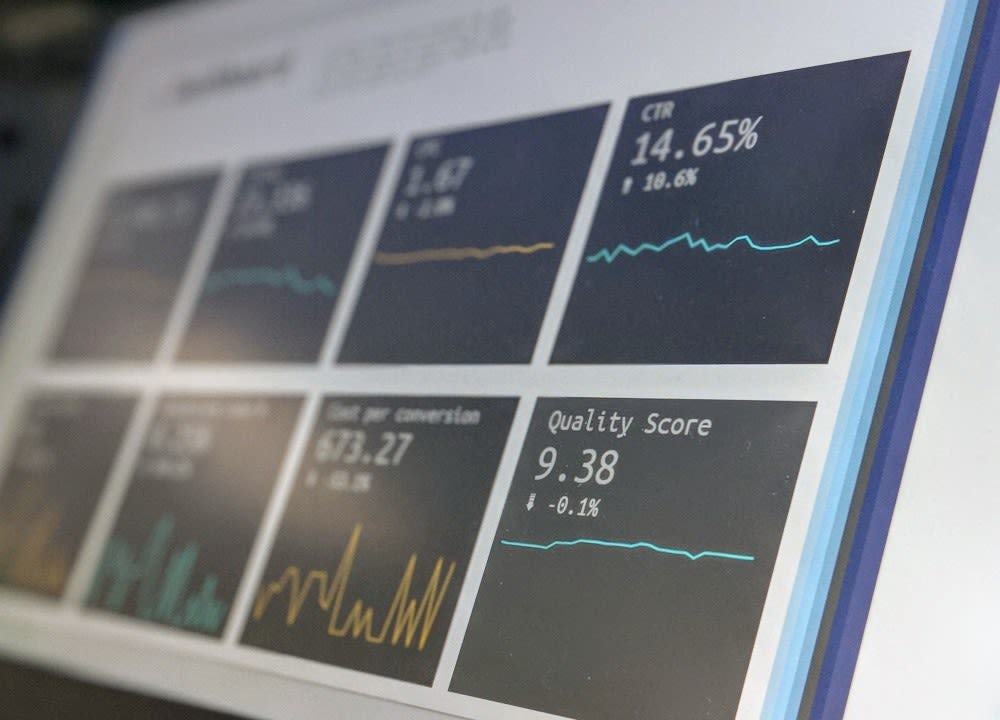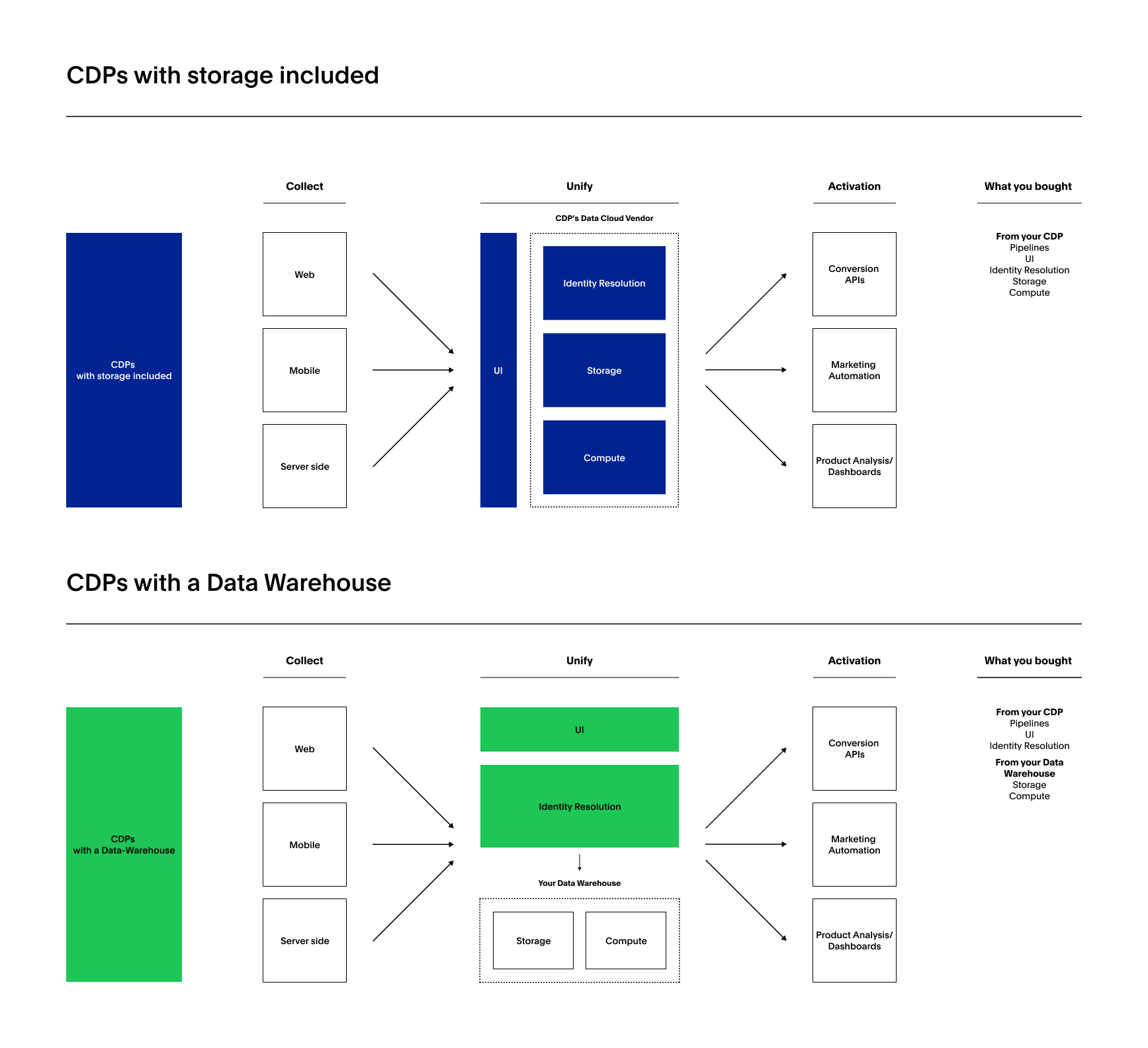Mastering Customer Data: The Synergy of CDPs and Data Warehouses

Published: February 5, 2024
Updated: April 10, 2024
Dive deep into the vital roles of Customer Data Platforms (CDPs) and Data Warehouses in mastering customer data for driving business growth and intelligent decision-making.
Understanding your customers isn't just beneficial—it's essential for business success. Every customer interaction, whether on your website or through your app, can be a goldmine of insights. The challenge lies in harnessing this data effectively, which is where Customer Data Platforms (CDPs) and data warehouses come into play.
Understanding the Role of CDPs in Data Management
Clarifying the CDP Confusion
A CDP is a sophisticated system designed to collect, unify, and activate customer data across various touchpoints in real-time, providing a complete view of each customer. This view is crucial for personalized marketing and customer experience strategies.
The Unique Function of CDPs
Unlike other data management tools, CDPs are built with a focus on customer-centric data. They excel in real-time data integration, identity resolution, and providing actionable insights, making them invaluable for businesses looking to leverage customer data for immediate use.
CDPs and Data Warehouses: Complementary Not Competing
Data Warehouses for Long-term Storage and Analysis
Data warehouses are designed for storing large volumes of data over time, excelling at historical data analysis, complex querying, and integrating various data types. They are essential for in-depth analytics, business intelligence, and long-term data strategies.
Synergistic Relationship
CDPs provide a real-time comprehensive view of customer data, feeding into data warehouses for deeper analysis. Insights from data warehouses can then inform and refine strategies executed through CDPs.
Complementing for Customer Identity Resolution
CDPs in the Forefront
CDPs manage and resolve customer identity across channels, offering immediate insights and actions to personalize customer experiences.
Data Warehouses as the Analytical Backbone
They complement CDPs by providing a broad historical context to customer data, enabling businesses to analyze long-term trends and behaviors.
Practical Application in Business
For example, a retailer might use a CDP to track a customer’s online shopping behavior and immediately send a personalized offer based on their browsing history. Simultaneously, the retailer’s data warehouse could analyze long-term purchase data to inform broader marketing strategies and customer segmentation.
What comes with your CDP?
To bundle or not to bundle
CDPs can be categorized into two data storage architectures:
Storage Included
In this model, your customers keep their data within their environment, and the CDP operates on the customer's own data warehouse. This setup is built for proprietary identity resolution within the customer's data cloud vendor.
Storage Sold Separately
These CDPs do not store customer data themselves. Instead, they rely on integrations with a data warehouse for both storing customer data and running computations to transform that data. Identity resolution typically happens via push-down SQL, written in the CDP's UI and executed on the customer’s data warehouse.

CDP and Data Warehouse Approaches
A diagram/illustration of the two primary variations of CDP capabilities and positioning in context with the presence of a data warehouse.
What's right for you?
For some companies, particularly those without a data warehouse, the fast implementation time of a bundled solution is appealing. Allowing your CDP to store customer data simplifies vendor management and ensures you maintain ownership of your customer data within your CDP.
Conversely, companies with their own data warehouse may find the "storage sold separately" option more beneficial. This approach leverages an existing data warehouse—potentially several years old—where key datasets for identity resolution already exist, creating a durable, long-term solution.
Your Next Steps with Gangverk
Understanding the distinct yet complementary roles of CDPs and data warehouses is crucial for any data-driven business. Gangverk specializes in navigating this complex landscape, ensuring that your business leverages both effectively for optimal customer data management and strategy. Reach out to explore how we can unlock your business’s potential through intelligent data management.
Frequently Asked Questions
What are Customer Data Platforms (CDPs) and how are they used?
Customer Data Platforms (CDPs) are systems designed to collect, unify, and activate customer data in real-time across various touchpoints. This provides businesses with a complete view of each customer, which is crucial for personalized marketing and customer experience strategies. CDPs excel at real-time data integration, identity resolution, and providing actionable insights from customer data.
How do Customer Data Platforms (CDPs) differ from data warehouses?
While CDPs focus on real-time customer data integration and activation, data warehouses are optimized for long-term storage, historical analysis, and complex querying across large datasets. CDPs provide an immediate, unified customer view to drive real-time engagement, while data warehouses enable deeper analysis of trends over time to inform broader strategies.
How do CDPs and data warehouses work together?
CDPs and data warehouses play complementary roles in managing customer data. CDPs collect real-time customer data across channels and feed these insights into data warehouses for deeper analysis over time. The insights from data warehouses can then refine the customer engagement strategies executed through the CDP. This synergy enables both real-time personalization and long-term optimization.
How are CDPs used for identity resolution?
CDPs are designed to resolve customer identities across channels in real-time, providing a unified view of each customer as they interact across touchpoints. This powers immediate personalization. Data warehouses provide historical context to enrich customer profiles over time, supporting the CDP's identity resolution capabilities.
What should businesses consider when implementing a CDP?
Businesses should consider whether they need a CDP with included data storage or the flexibility to integrate with their existing data warehouse. Companies without a data warehouse may benefit more from bundled CDP storage for faster implementation. However, companies with an established data warehouse can leverage it for identity resolution and long-term storage while connecting it to a CDP for real-time activation.

